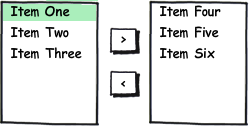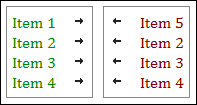Moving List Items Between Lists
I often apply a push-pull pattern when working with business/data interfaces. I’m talking about something like this:

I don’t much like these so I came up with something similar that works well for small datasets which I’ll describe here. Here it is in action:
and here’s how to build it. First, the basic layout:
<body>
<ul id='list1'>
<li>Item 1 <img class='icon move' src='blank.png'/></li>
<li>Item 2 <img class='icon move' src='blank.png'/></li>
<li>Item 3 <img class='icon move' src='blank.png'/></li>
<li>Item 4 <img class='icon move' src='blank.png'/></li>
</ul>
<ul id='list2'>
<li>Item 5 <img class='icon move' src='blank.png'/></li>
<li>Item 6 <img class='icon move' src='blank.png'/></li>
<li>Item 7 <img class='icon move' src='blank.png'/></li>
<li>Item 8 <img class='icon move' src='blank.png'/></li>
</ul>
</body>
What I want to do is have each li hop to the opposing list when its move button is clicked. It’s very simple with jQuery’s live event binding (demo, source):
$(function(){
$('ul#list1 .move').live('click', function(){
$(this).closest('li').appendTo('ul#list2');
});
$('ul#list2 .move').live('click', function(){
$(this).closest('li').appendTo('ul#list1');
});
});
These events aren’t bound to the items themselves. Rather they sit higher up the DOM and, through some event delegation magic, are handled by any li matching the selector (including elements appended in the future). So when an li’s move icon is clicked, the event handler walks up the DOM until it finds the li element, and moves it to the other list via a call to appendTo(). This technique can be combined with jQuery UI’s sortable component, too, for drag/drop and reorder support, too.
It’s also really easy to add animation (demo, source):
$(function(){
$('ul#list1 .move').live('click', function(){
$li = $(this).closest('li');
$li.fadeOut('slow', function(){ $li.appendTo('ul#list2').fadeIn(); });
});
$('ul#list2 .move').live('click', function(){
$li = $(this).closest('li');
$li.fadeOut('slow', function(){ $li.appendTo('ul#list1').fadeIn(); });
});
});
Now we’re getting to the point where some refactoring might be appropriate (demo, source):
$.fn.pushTo = function(toSelector)
{
$this = $(this);
return $this.fadeOut('slow', function(){ $this.appendTo(toSelector).fadeIn(); });
};
$(function(){
$('ul#list1 .move').live('click', function(){
$(this).closest('li').pushTo('ul#list2');
});
$('ul#list2 .move').live('click', function(){
$(this).closest('li').pushTo('ul#list1');
});
});
It’s not really any less code, but we’ve moved the messy animation pieces out into a chainable function. I could have moved the .closest() pieces into the function, too, but that would make the pushTo() method a little too specific to this task for my taste. Since we have the animation isolated to one line, we can easily change it to slide the items in and out (demo, source):
$.fn.pushTo = function(toSelector)
{
$this = $(this);
$this.slideUp('slow', function(){ $this.appendTo(toSelector).slideDown(); });
return $this;
};
Finally, if you use something like this in a real app, use ‘fast’ for the animation speed. I’m using ‘slow’ here to make it obvious. In practice, though, it’d be very annoying.

